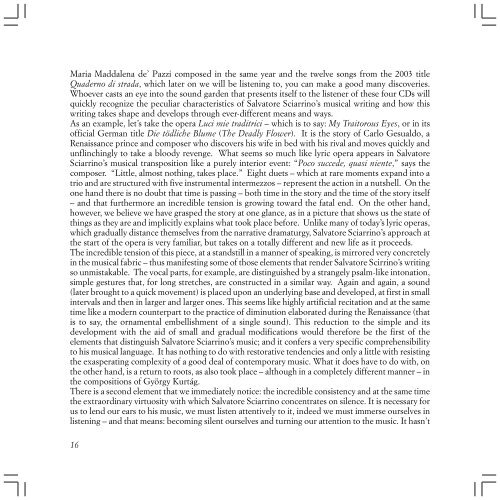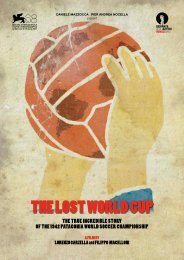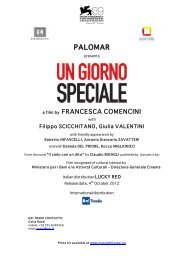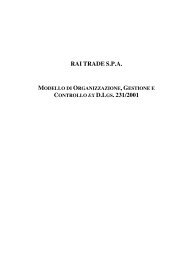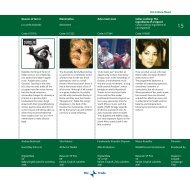Salvatore Sciarrino - Rai Trade
Salvatore Sciarrino - Rai Trade
Salvatore Sciarrino - Rai Trade
Create successful ePaper yourself
Turn your PDF publications into a flip-book with our unique Google optimized e-Paper software.
Maria Maddalena de’ Pazzi composed in the same year and the twelve songs from the 2003 title<br />
Quaderno di strada, which later on we will be listening to, you can make a good many discoveries.<br />
Whoever casts an eye into the sound garden that presents itself to the listener of these four CDs will<br />
quickly recognize the peculiar characteristics of <strong>Salvatore</strong> <strong>Sciarrino</strong>’s musical writing and how this<br />
writing takes shape and develops through ever-different means and ways.<br />
As an example, let’s take the opera Luci mie traditrici – which is to say: My Traitorous Eyes, or in its<br />
official German title Die tödliche Blume (The Deadly Flower). It is the story of Carlo Gesualdo, a<br />
Renaissance prince and composer who discovers his wife in bed with his rival and moves quickly and<br />
unflinchingly to take a bloody revenge. What seems so much like lyric opera appears in <strong>Salvatore</strong><br />
<strong>Sciarrino</strong>’s musical transposition like a purely interior event: “Poco succede, quasi niente,” says the<br />
composer. “Little, almost nothing, takes place.” Eight duets – which at rare moments expand into a<br />
trio and are structured with five instrumental intermezzos – represent the action in a nutshell. On the<br />
one hand there is no doubt that time is passing – both time in the story and the time of the story itself<br />
– and that furthermore an incredible tension is growing toward the fatal end. On the other hand,<br />
however, we believe we have grasped the story at one glance, as in a picture that shows us the state of<br />
things as they are and implicitly explains what took place before. Unlike many of today’s lyric operas,<br />
which gradually distance themselves from the narrative dramaturgy, <strong>Salvatore</strong> <strong>Sciarrino</strong>’s approach at<br />
the start of the opera is very familiar, but takes on a totally different and new life as it proceeds.<br />
The incredible tension of this piece, at a standstill in a manner of speaking, is mirrored very concretely<br />
in the musical fabric – thus manifesting some of those elements that render <strong>Salvatore</strong> Scirrino’s writing<br />
so unmistakable. The vocal parts, for example, are distinguished by a strangely psalm-like intonation,<br />
simple gestures that, for long stretches, are constructed in a similar way. Again and again, a sound<br />
(later brought to a quick movement) is placed upon an underlying base and developed, at first in small<br />
intervals and then in larger and larger ones. This seems like highly artificial recitation and at the same<br />
time like a modern counterpart to the practice of diminution elaborated during the Renaissance (that<br />
is to say, the ornamental embellishment of a single sound). This reduction to the simple and its<br />
development with the aid of small and gradual modifications would therefore be the first of the<br />
elements that distinguish <strong>Salvatore</strong> <strong>Sciarrino</strong>’s music; and it confers a very specific comprehensibility<br />
to his musical language. It has nothing to do with restorative tendencies and only a little with resisting<br />
the exasperating complexity of a good deal of contemporary music. What it does have to do with, on<br />
the other hand, is a return to roots, as also took place – although in a completely different manner – in<br />
the compositions of György Kurtág.<br />
There is a second element that we immediately notice: the incredible consistency and at the same time<br />
the extraordinary virtuosity with which <strong>Salvatore</strong> <strong>Sciarrino</strong> concentrates on silence. It is necessary for<br />
us to lend our ears to his music, we must listen attentively to it, indeed we must immerse ourselves in<br />
listening – and that means: becoming silent ourselves and turning our attention to the music. It hasn’t<br />
16


